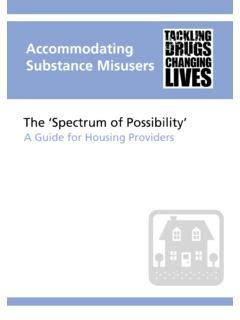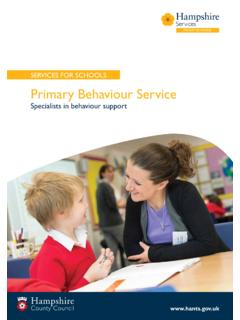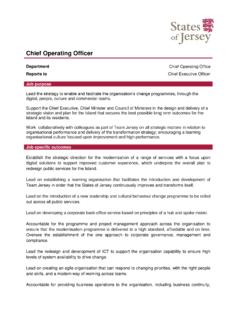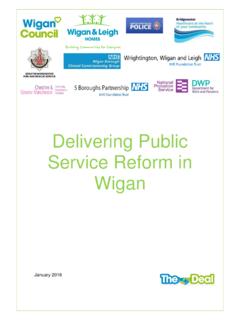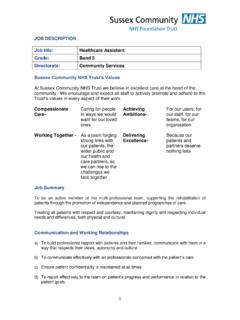Transcription of TACKLING DRUG USE IN RENTED HOUSING
1 TACKLING drug USE IN RENTED HOUSINGA Good Practice GuideTackling Drugs in RENTED HOUSING A Good Practice Guide1 CONTENTSC ontentsExecutive summary51 Setting the scene9 Social Landlords9 drug Action Teams and drug Reference Groups9 Crime and Disorder Reduction Partnerships9 Alcohol, prescribed drugs and problematic drug use102 Drugs, crime, anti-social behaviour and HOUSING 11 Links between drugs, alcohol and crime11 drug -related anti-social behaviour12 Community consultation13 The role of HOUSING in neighbourhood renewal13 Best Value in housing14 The role of social landlords in regeneration14 Priorities for neighbourhood regeneration16 Displacement17 Physical improvements17 TACKLING drug -related supply as part of estate regeneration17 Controlling supply as an integrated tool of neighbourhood renewal 18 Services for young people19 Confidentiality and information sharing between agencies193 Specific HOUSING management interventionsin relation to drugs22 Tenancy allocation and sustainable communities22 Introductory and starter tenancies23 Tenancy agreement25 Actions to prevent anti-social behaviour26 Neighbourhood wardens26 Mediation26 Injunctions27 Anti-Social Behaviour Orders28 Acceptable
2 Behaviour Contracts28 Evictions29 Private landlords304 Resettlement, treatment and rehabilitation the role of HOUSING providers32 HOUSING supporting drug users to overcome dependency322 TACKLING Drugs in RENTED HOUSING A Good Practice GuideCONTENTSM anaging supported HOUSING for drug users: an example ofgood practice32 drug users as vulnerable people33 Planning to meet the support needs of drug users34 Assessing the support needs of drug users34 Delivering support to vulnerable tenants35 Agency-based support36 Floating support37 people living independently for the first time37 Care leavers38 Drugs and mental health39 Tenants with current or recent contact with the criminal justice process40Ex-prisoners40 Probation41 HOUSING support for ex-offenders41 Measuring the impact of supported housing42 Supporting People425 Supporting drug users in HOUSING issues for managers and staff44 drug use and tenancies44 Section 8 of the Misuse of Drugs Act 197145 Staff training and support48 Responses to discarded injecting equipment496 Conclusions51 Bibliography and suggested further reading 52
3 References 53 Appendix 1: 55 Procedures and powers available to act againsta house and its tenants involved in drug supplyAppendix 2: Glossary of terms59 Appendix 3: drug treatment64 What is treatment?64 Ways into treatment64 drug treatment services64 Types of intervention67 Useful contacts69 FOREWARDT ackling Drugs in RENTED HOUSING A Good Practice Guide3 FOREWORDF orewordWho this document is forThis good practice guide is aimed primarily at local authority housingdepartments and registered social landlords (RSLs) operating in guide will also be of benefit to drug Action Teams, Crime DisorderReduction Partnerships, drug services, the police and others with aresponsibility for addressing drug -related issues in local will be of interest to those providing HOUSING services in Scotlandand this guidance is neededThe issue of drugs within RENTED HOUSING is important for managers ofsocial HOUSING as well as other agencies responsible for preventing anddealing with crime and anti-social behaviour.
4 The role that HOUSING canplay should be recognised as a vital part of local drug strategies by thoseresponsible for the provision and commissioning of drug services. The primary purpose of this guide is to help develop strategies to ensurethat communities are not adversely affected by the consequences ofillegal drugs whilst simultaneously ensuring that drug users aresupported in their treatment and rehabilitation through access toappropriate HOUSING . In developing strategies to deal with crime andanti-social behaviour, local HOUSING services should be aware of the needto address problems associated with illegal of the guidanceThe guidance has been produced jointly by the Home Office DrugStrategy Directorate (DSD), the Drugs Prevention Advisory Service(DPAS) and Release, the national drugs and legal charity.
5 It is based oninformation gathered through an extensive review of existing literatureand draws on examples of existing good practice across England. The following organisations or initiatives were visited or interviewed inthe course of this research:Bleach Green Estate, GatesheadBrighton and Hove Special Needs HOUSING ProjectCAN Homeless Action Team, NorthamptonshireCastle Vale HOUSING Action Trust, BirminghamCoventry and Warwickshire Substance Misuse Initiative HousingSupport Project4 TACKLING Drugs in RENTED HOUSING A Good Practice GuideFOREWORDM onsall Residents Association, ManchesterPhoenix House drug and Alcohol Floating Support Service, LondonTower Hamlets Accommodation Project, LondonThe project was steered by an advisory group whose valuable commentswere extremely helpful in shaping the drafting of the document.
6 They were:Robin Burgess (DPAS/DSD)Gail Heath (Northern Counties HOUSING Association, representingNational HOUSING Federation) Trevor Lincoln (Leeds City Council, representing the LocalGovernment Association)Chris McCormack (DPAS)Fiona MacKay (DPAS)Rosie Higgins (DPAS)Geeta Nanda Octavia Hill HOUSING Trust, representing the NationalHousing Federation (NHF)Thanks also to the following who contributed extensively:Jan Bird (Department of Transport and the Local Government Regions,DTLR)Maureen Adams ( HOUSING Corporation)Helen Williams (National HOUSING Federation)Gerard Murden then Liverpool City Council, representing the LocalGovernment Association (LGA)The good practice guide has been written by the Inclusion team atRelease. Inclusion is a partnership between Release and the CamelotFoundation, and seeks to support professionals working with sociallyexcluded young people in preventing the onset of problematic drug useand related : Ian Robinson and Kevin Flemen (Release)Background research: Dave Wilson and Fiona McLean (Release)Edited by Robin Burgess and Bridget LawlessTackling Drugs in RENTED HOUSING A Good Practice Guide5 EXECUTIVE SUMMARYE xecutive summarySetting the sceneProviders of social HOUSING have an increasing role, alongside otherpartners, to combat anti-social behaviour.
7 The effects of drug use oncommunities can be pernicious, and the needs of individual drug usersshould be balanced against those of the wider community. Problematic drug use is often symptomatic of other social and economicproblems, including high levels of unemployment, deprivation and crime,and can be seen both as a cause and a symptom of neighbourhooddecline. HOUSING managers can, and do, play a crucial role in combatingproblems associated with drug use through efforts to regenerateneighbourhoods, dealing with anti-social behaviour and supporting theprovision of effective treatment outcomes for individual drug of social HOUSING play a crucial role in helping to deliver thenational drugs strategy, TACKLING Drugs to Build a Better , crime, anti-social behaviour and housingSome aspects of drug -related anti-social behaviour are straightforward:use of drugs on stairwells and other public areas, discarded needles andother drug -related paraphernalia, and open dealing from properties orpublic spaces.
8 Other activities are not so clearly drug -related, such ascrime against property, groups of young people congregating in publicspaces, prostitution and consultationMembers of the local community, including those who live and work onan estate or neighbourhood, should be fully involved in the planning and implementation of any initiatives. Efforts should be made to ensurethat consultation is representative and actively involves all members ofthe community. This should include proactive steps to consult withminority ethnic communities, young people , lesbians and gay men, anddrug users. The role of HOUSING in TACKLING drug issues as part of renewalEfforts to combat drug -related problems in RENTED HOUSING should include: integration of drug strategies into regeneration programmes physical improvements designing out drug use planned action against supply6 TACKLING Drugs in RENTED HOUSING A Good Practice GuideEXECUTIVE SUMMARY HOUSING management that is responsive to drug use work with young people close co-operation between and housingSome estates are so badly damaged by unemployment and anti-socialbehaviour, including drugs, that a programme of economic and socialregeneration needs to take place.
9 A comprehensive package of measuresshould include physical improvements which will in turn impact on druguse and especially supply: Street lighting CCTV Security to buildings Creation of defensible space Opening up of secluded properties Demolition of some properties Construction of new improved properties or major improvements to older funding, such as New Deal for Communities and SingleRegeneration Budget, has been used effectively for these managementHigh-quality HOUSING management brings effective solutions to drugproblems by managing anti-social behaviour through to supportingtenancies for those overcoming drug problems. Social landlords cancontribute to the safety of communities, TACKLING anti-social behaviourand thereby reduce problematic drug use. They should look at: tenancy agreements tenancy allocation sustainable communities introductory and starter behaviour of some individuals can adversely affect others.
10 Landlordsshould consider action to prevent anti-social behaviour, including: mediation injunctions Acceptable Behaviour Contracts Anti-Social Behaviour Drugs in RENTED HOUSING A Good Practice Guide7 EXECUTIVE SUMMARYP artnership and joined-up workingAs part of this HOUSING Plusapproach, and taking forward Best Value,social landlords need to work effectively with other key agencies ( , youth and social services), other landlords and the members ofthe community. Good inter-agency working means a commitment fromeach agency based on protocols covering information sharing andconfidentiality and unpopular housingProblematic drug use can both be a factor creating unpopular housingand a negative consequence of it. Such problems are often symptomaticof longer decline and need to be tackled through economic and socialprogrammes, including large-scale physical improvements.
